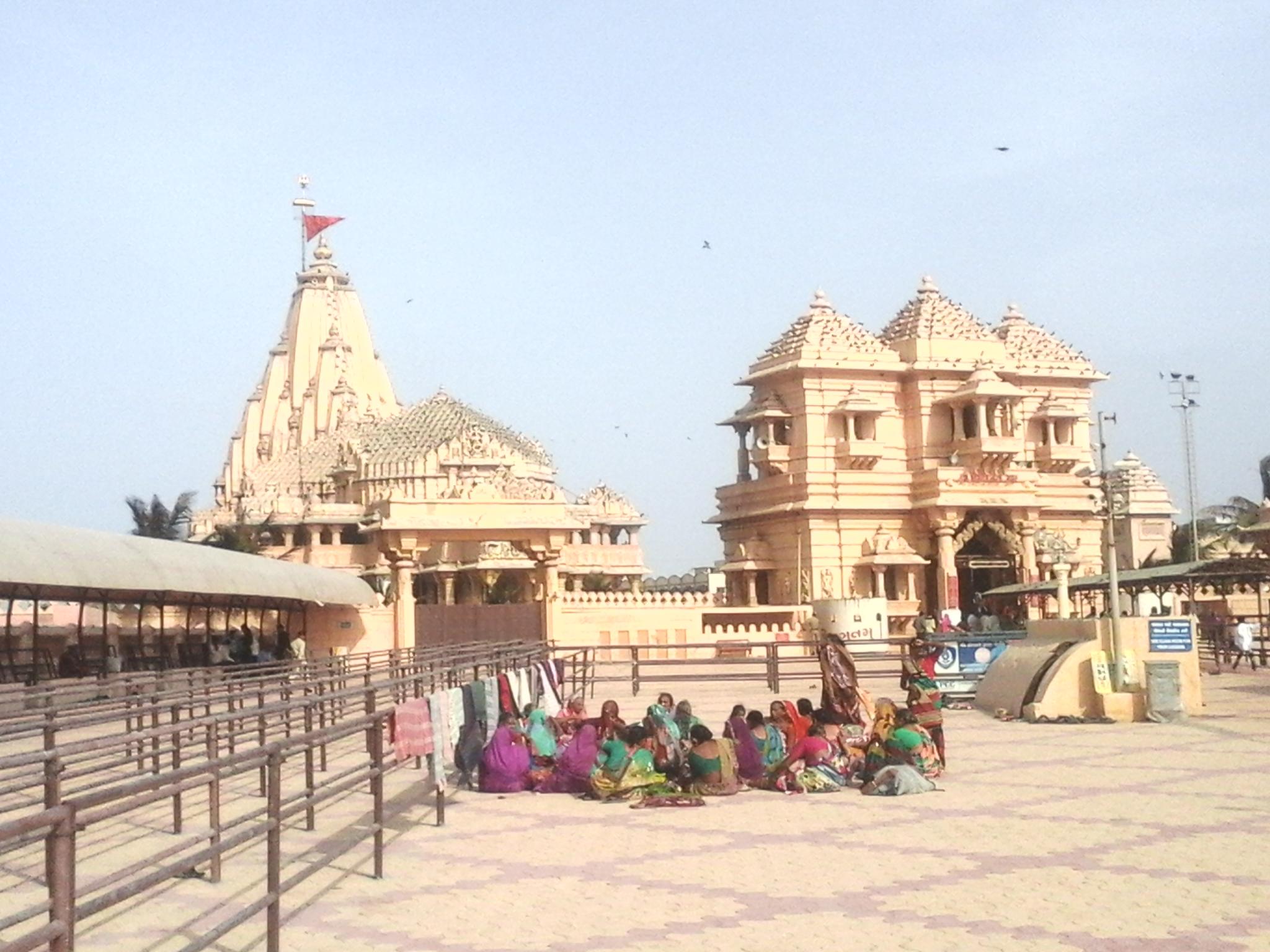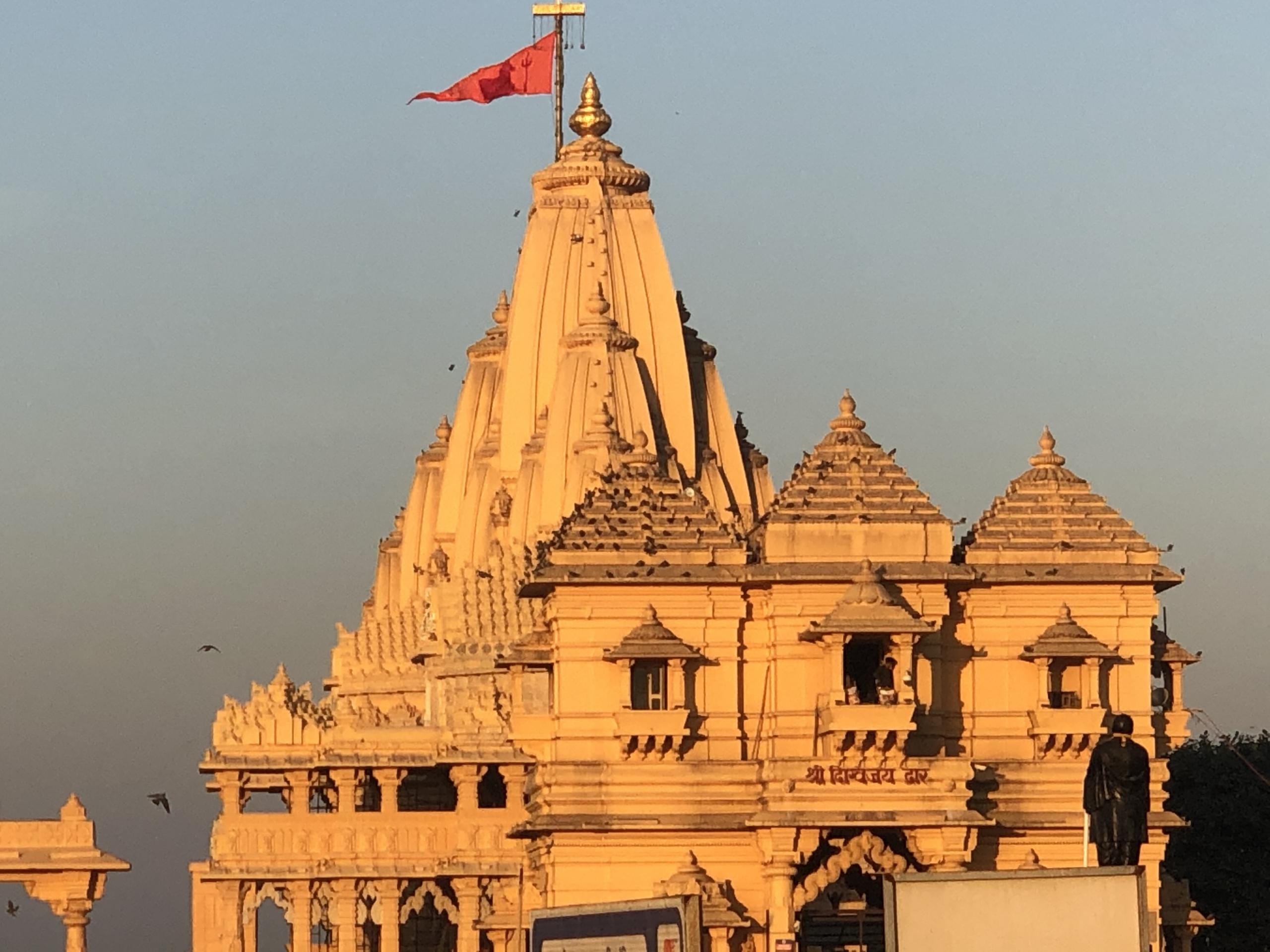Somnath Temple is shrouded in mystical legends and a tragic history of plunder after plunder.
Its incredible story starts from the beginning of all things and is fascinating and full of wonder.
Find out all the intricate details behind this magical temple!

The History of Somnath Temple
The very beginnings of this temple are disputed by scholars, depending on which school of thought they come from.
The Temple Built Before Time
According to Swami Gajanand Saraswati, the first iteration of Somnath Temple was built 7,99,25,105 years ago. He came to this number after studying the traditions of Prabhas Khand of Skand Puran.
Specifically, it was determined that the temple (sometimes referred to as Somnath Jyotirling Pran-Pratistha) was built on the auspicious third day of the brighter half of Shravan month during the tenth Treta yug of Vaivswat Manvantar.
Regardless of the accuracy of this claim, the land the temple lies on has been regarded as a tirtha for as long as records go back. While the temple was not mentioned in the ancient Sanskrit texts of Hinduism, the "Prabhasa-Pattana" (Prabhas Patan) area, where the temple is now, is mentioned as a holy site for pilgrimage because it is a Triveni Sangam (where the three holy rivers Kapila, Hiran, and Saraswati converge).

A More Modern Approach
Based on historical records, historians give a more conservative estimate of the age of the temple. While its exact date of construction isn’t known, it’s estimated to have been built between the 1st and 10th centuries, but it’s most likely that the temple was built in the late 10th century.
The name Someshvara began to appear in the 9th century, in a writing which states that King Nagabhata II went on pilgrimage to Saurashtra and visited a site called Someshvara, which may indicate the presence of a temple. But, it could also mean he visited the land where the 3 rivers converged, with no temple. So, it’s difficult to know when the temple was built for certain.
Build and Rebuild, and Rebuild Again!
We know for certain that the temple was around before 1026 CE because that’s when Somnath suffered its first raid.
Apparently, a review of the temple written by Arab traveller Al-Biruni was so incredible, boasting of the wealth and beauty of the place, that it attracted the attention of Afghan/Turk Mahmud of Ghazni. Mahmud was a legendary looter, so naturally, he plundered the famed temple after a two-day battle, slaying 70,000 defenders. He did this with the overall goal of weakening Hinduism and strengthening Islam.
The temple was completely destroyed.
And then, by 1038, it was rebuilt. In fact, the temple was plundered and rebuilt at least 3 more times throughout history.
Why Was Somnath Temple Looted So Much?
The Temple was razed in 1026, 1299, 1395, and 1665.
But why was this happening so much to this one temple?
The answer lies in its location. The temple is located on the seaside and was a hub for travellers going to and from Zanj (in southeast Africa) and China. It was a well-known feature in the area and kept amassing wealth even after destruction, making it a prime target for more attacks in the name of Islam. The Muslim rulers of the time wanted to stamp out Hindu holy sites, so they repeatedly plundered this shining, prominent temple.
Magic and Legends of Somnath Temple
What makes the history of Somnath Temple so auspicious?
The spiritual origins of the temple are incredible and utterly fascinating.
The First Jyotirlinga
According to Hindu history, Somnath is the very first of the 64 Jyotirlingham, and the holiest of the 12 especially holy sites, mentioned in the Shiva Purana. The word “jyotirlingam” means “sign of radiance.”
It is said that, in order to settle the argument between Lord Brahma and Lord Vishnu about who was more supreme, Lord Shiva turned into Jyotirlinga - a huge, infinite pillar of light. The areas where Shiva appeared as a fiery light are the original 64 Jyotirlingam.
Temple Built by the Moon God
Another legend makes this site of the first Jyotirlingham even more sacred.
It is said that Chandra, the Moon God, was cursed by his father-in-law for not loving all of his wives (27 of them, all sisters) equally. Daksha Prajapati, the father-in-law, then cursed Chandra to lose his light.
In order to regain his light, Chandra offered penance to Lord Shiva and asked to be granted a boon. Shiva was pleased with Chandra’s devotion, and so he granted the boon. Chandra either bathed in the holy Saraswati River or was placed on Lord Shiva’s head, depending on the legend. This caused him to regain his light.
This legend explains the phases of the moon from light to dark and back again.
In Pauranic traditions, it’s said that Chandra was so thankful to Shiva that he built Somnath Temple (a name which means [Lord Shiva is] the Lord of the Moon) out of gold out of gratitude.
According to the story, the temple was then renovated in silver by Ravana, and then Sandalwood by Bhagavan Shree Krishna.
The Levitating Lingham
According to legend, the Lingham that Chandra had originally installed in the temple was able to float in mid-air.
There is no real evidence of the truth of this claim, but there are two theories as to how it was achieved.
First, it’s hypothesized that the Shivling contained the Syamantak Mani, aka the Philosopher’s Stone. The magical stone, which could create gold, was theorized to have alchemic and radioactive properties that could create a magnetic field around it and allow it to float. This theory is not rooted in the science we know today.
It’s also worth noting that according to history, Mahmud broke the lingham, and yet the mention of a philosopher’s stone hidden inside is nowhere to be found.
The Somnath temple signifies that the power of reconstruction is always greater than the power of destruction. By rising from its ashes again, this temple of Somnath is to say proclaiming to the world that no man and no power in the world can destroy that for which people have boundless faith and love in their hearts. - Dr Rajendra Prasad, President of India
The other explanation is that the lingham consists of iron, and the roof of the sanctum was made of lodestone (magnetite), which has magnetic properties. The architect of the sanctum was able to construct the room just so, that the lingham was pulled up by magnets and pulled down by gravity in a way that would allow it to float.
This explanation is also not backed by modern science, and again, there is no evidence that a floating Shivling ever actually existed.
The Temple That Exists Through Time
As you may recall, Somnath Temple was estimated by Hindu scholar Swami Saraswati to have existed 7,99,25,105 years ago.
Likewise, the holy texts state that the temple will continue to exist - even after the destruction of the world.
According to the Prabhaskhand of Skanda Purana, Somnath Temple is destined to change names with each destruction of the world. The world is destroyed and reconstructed periodically by Brahma, of which there have been about 6. The Skanda Purana states that the Brahma in this Yuga (age of time) is named Shatanand, and Somnath is the name for the temple during this Yuga.
Lord Shiva states that Somnath has been renamed 7 or 8 times. He says the last name of the temple, in the previous Yuga, was Mrityunjay. In the next, it will be called Pran Nath Temple.

Fun Facts About Somnath
There is so much more about the Somnath Temple that cannot be summed up easily! It has a fantastical history. Here are some of the best facts about Somnath Temple.
- The land the temple is built upon is referenced in ancient texts like Shreemad Bhagavat, Skandpuran, Shivpuran, and Rig-Veda as being a holy site.
- The Baan Stambh, or Arrow Pillar, built on the beach near the temple indicates an unobstructed path all the way to Antarctica. Is it a coincidence? If not, what does it mean? Nobody knows for sure.
- At some point, an attempt was made to convert the temple into a mosque. This is how it was found in 1950 when renovations were to be made. The mosque pieces were moved to a site a few kilometers away.

Planning Your Visit to Somnath Temple
Somnath Temple is still a very active Hindu temple and pilgrimage site dedicated to Shiva.
The most recent iteration of the temple was built in 1950-1951 at the behest of Vallabhbhai Patel and was inaugurated by then-President of India Dr Rajendra Prasad.
Somnath Temple Timings
The temple is open every day from 6 AM to 9 PM.
The Light and Sound Show is not held during monsoon season.
How to Get to the Temple
The temple is well-connected via many modes of transportation.
- By Air: The nearest airport is DIU which is 85 km away from the temple.
- By Train: The nearest railway station is Somnath (0.5 km). Regular train service is available from all major cities in Gujarat. The second-nearest train is Veraval (7 km).
- By Road: Somnath connects well to major cities in Gujarat like Ahmedabad, Junagadh, Dwarka, and Chorwad by state roadways.
Fees and Code of Conduct
The temple is free for all who follow the Hindu faith. However, non-Hindus will need to obtain special permission from temple authorities to gain entry.
There are no electronics allowed as you explore the temple, so they must all be kept in the complementary Cloak Room, along with your shoes.
Photography and smoking are strictly prohibited.
Visitors should ensure to cover up to their elbows and knees, as inappropriate clothing is not allowed.
The best time of year to visit the temple is between October and March, to avoid the hot, humid summer.
References
- “Jay Somnath.” Jay Somnath | Somnath.Org, somnath.org/. Accessed 27 Nov. 2023.
- “The Somnath Temple.” The Somnath Temple | District Gir Somnath, Government of Gujarat | India, girsomnath.nic.in/tourist-place/the-somnath-temple/. Accessed 27 Nov. 2023.
- Tourism, Gujarat. “Shree Somnath Jyotirlinga Temple.” Shree Somnath Jyotirlinga Temple, www.gujarattourism.com/saurashtra/gir-somnath/somnath-temple.html. Accessed 27 Nov. 2023.















